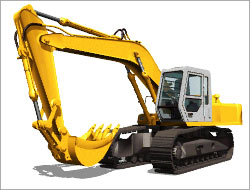

12 October 2010- Excavators are heavy equipment used in civil engineering and surface mining. An excavator, also called a 360-degree excavator or digger, sometimes abbreviated simply to a 360, is an engineering vehicle consisting of a backhoe and cab mounted on a pivot (turntable is a more apt description) atop an undercarriage with tracks or wheels. The term excavator is sometimes used as a general term for any piece of digging equipment.
Excavators are used in many roles:
1- Digging of trenches, holes, foundations
2- Demolition
3- General grading/landscaping
4- Heavy lift, e.g. lifting and placing of pipes
5- River dredging
6- Mining, especially, but not only open-pit mining
7- Brush cutting with hydraulic attachments

Excavators come in a wide variety of sizes. The smaller ones are called a mini-excavator or compact excavator. One manufacturer's largest model weighs 84,980 kg (187,360 lb) and has a maximum bucket size of 4.5 m� (5.9 yd�). The same manufacturer's smallest mini-excavator weighs 1470 kg (3240 lb), has a maximum bucket size of 0.036 m� (0.048 yd�) and the width of its tracks can be adjusted to 89 cm (35 inches). Another company makes a mini excavator that will fit through a doorway with tracks that can be adjusted to only 70 cm (28 inches) wide.
Often the bucket can be replaced with other tools like a breaker, a grapple or an auger. Excavators are usually employed together with loaders and bulldozers. Most smaller excavators have a small backfill (or dozer-) blade. It's a horizontal bulldozer like blade attached to the undercarriage and is used for pushing removed material back into a hole.
1- Compact excavator
A compact hydraulic excavator is a tracked or wheeled vehicle with an approximate operating weight of 6 metric tons (13,228 lbs). It generally includes a standard backfill blade and features independent boom swing. The compact hydraulic excavator is also referred to as a mini excavator.
The compact hydraulic excavator is somewhat unique from other construction equipment in that all movement and functions of the machine are accomplished through the transfer of hydraulic fluid. The compact excavator's work group and blade are activated by hydraulic fluid acting upon hydraulic cylinders. The excavator's slew (rotation) and travel functions are also activated by hydraulic fluid powering hydraulic motors.
2- Dragline excavator
Dragline excavation systems are heavy equipment used in civil engineering and surface mining. In civil engineering the smaller types are used for road and port construction. The larger types are used in strip-mining operations to extract coal and these are amongst the largest mobile equipment (not water-borne), and weigh in the vinicity of 2000 metric tonnes, though specimens weighing up to 13,000 metric tonnes have also been constructed.
A dragline bucket system consists of a large bucket which is suspended from a boom (a large truss like structure). The bucket is maneuvered by means of a number of ropes and chains. The hoistrope, powered by large diesel or electric motors, supports the bucket and hoist-coupler assembly from the boom. The dragrope is used to draw the bucket assembly horizontally. By skillful maneuver of the hoist and the dragropes the bucket is controlled for various operations.
3- Bucket-wheel excavator
Bucket-wheel excavators are heavy equipment used in surface mining and civil engineering. The excavation component itself is a large rotating wheel mounted on an arm or boom. On the outer edge of the wheel is a series of scoops or buckets. As the wheel turns, the buckets remove soil or rock from the target area and carry it around to the backside of the wheel, where it falls onto a conveyor, which carries it up the arm toward the main body of the excavator. Additional conveyors then may carry it further; in some cases, several long conveyors are placed end-to-end, each supported by a large vehicular base.
Especially large bucket-wheel excavators, over 200 meters long and up to 100 meters in height, are used in German strip-mining operations, and are the largest earth-movers in the world. These tremendous machines can cost over $100 million, take 5 years to assemble, require 5 people to operate, weigh more than 13,000 tons, and have a theoretical capacity of more than 12,000m�/h. Specifically, the RB293 bucket wheel excavator manufactured by MAN Takraf is recognized by Guinness World Records as the largest land vehicle.
Article Source:technology-articles/excavator-an-commonly-used-heavy-machinery-50112.html
About the Author